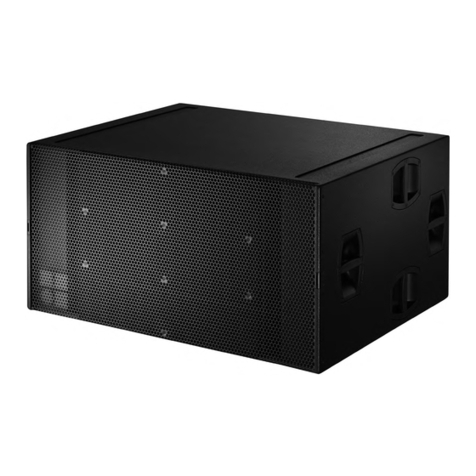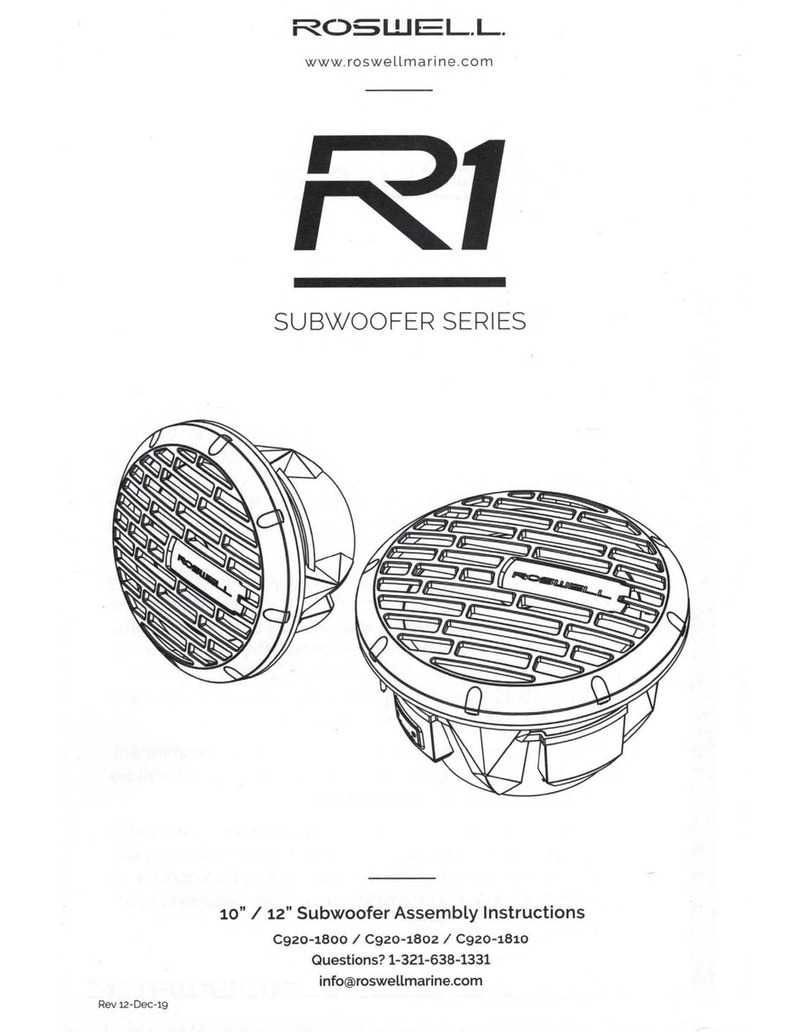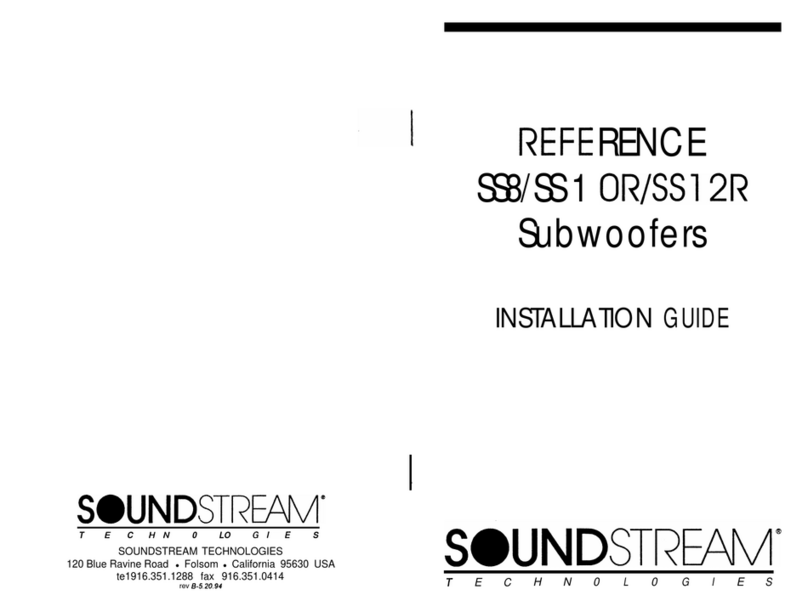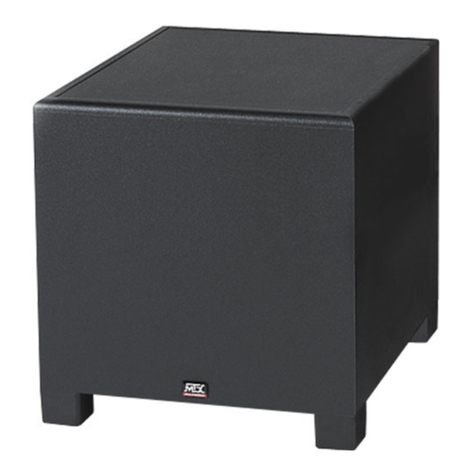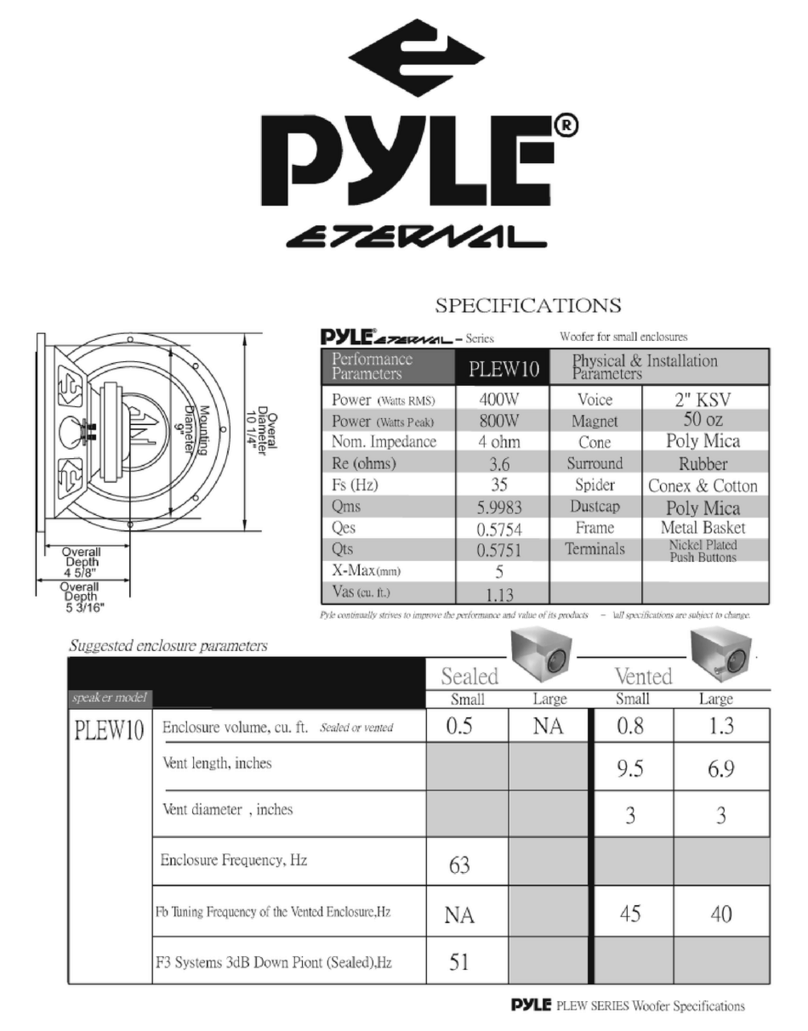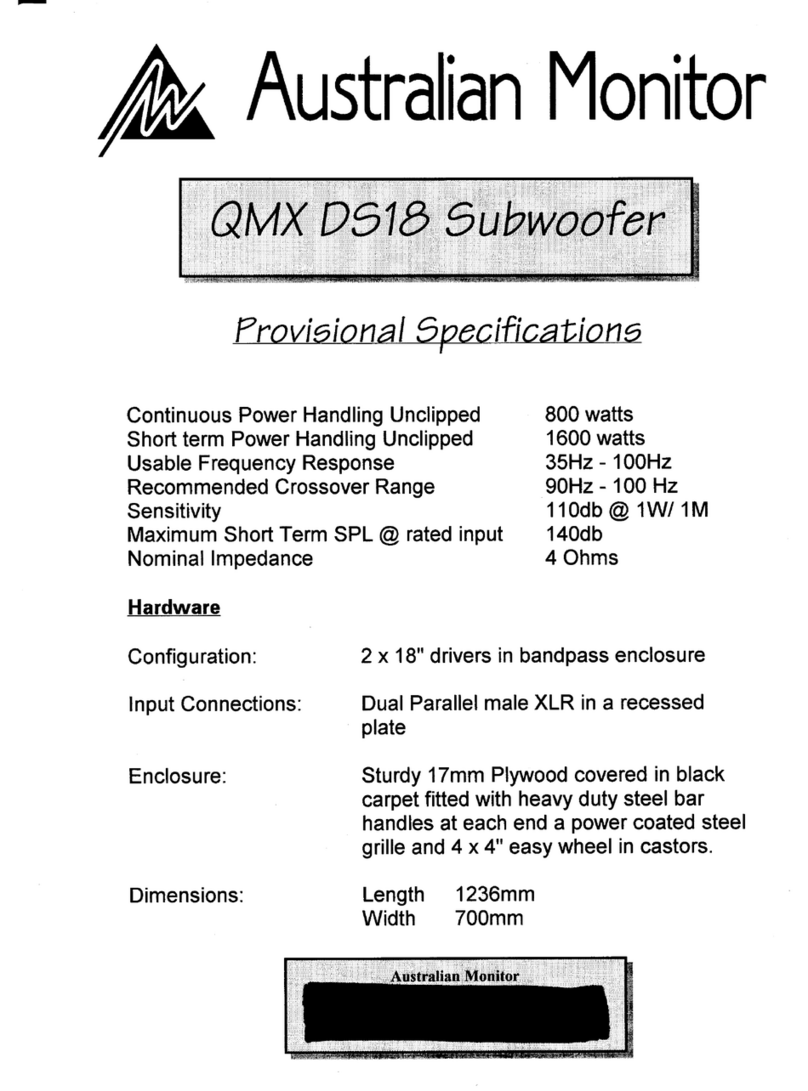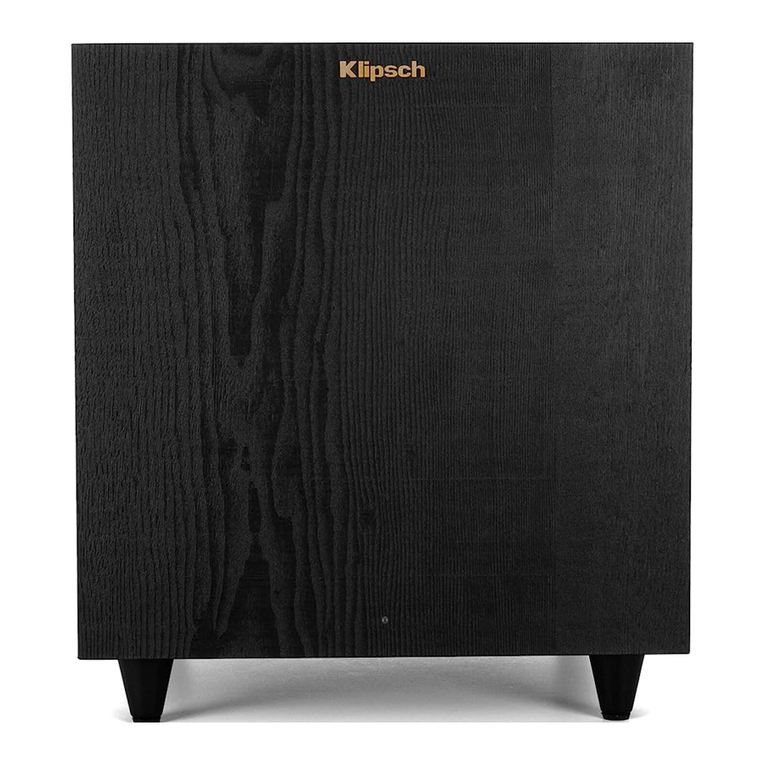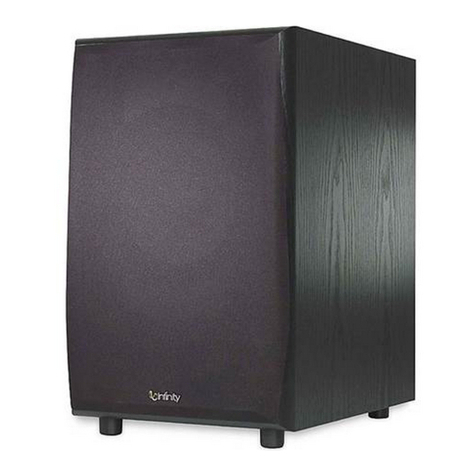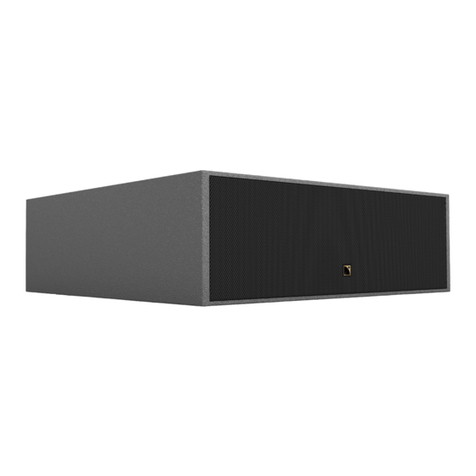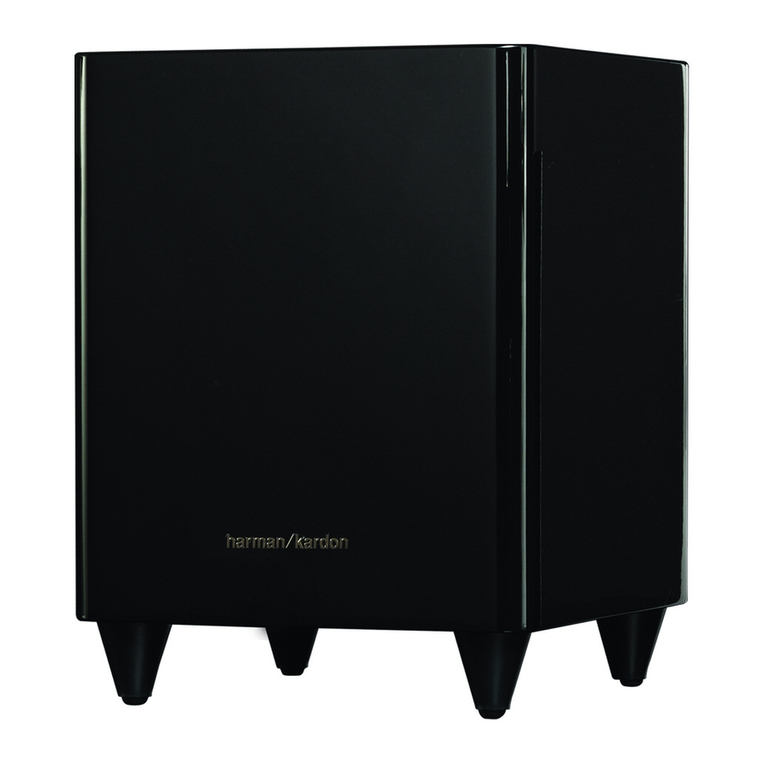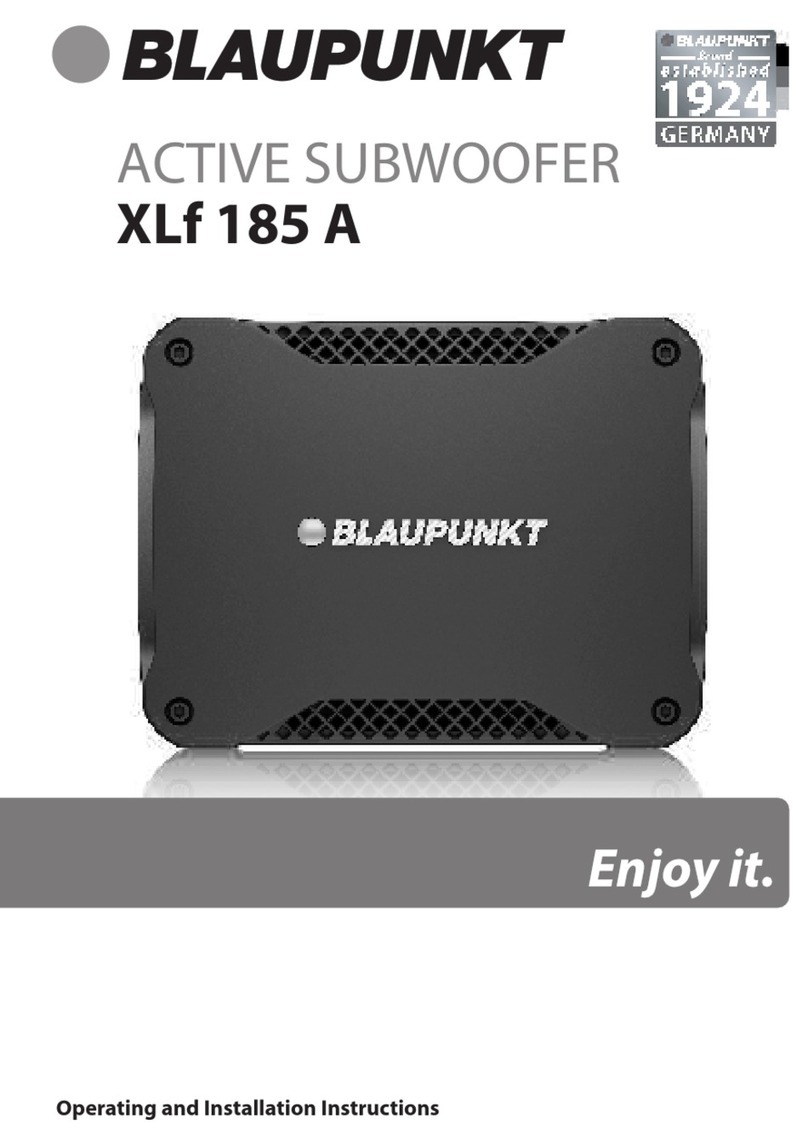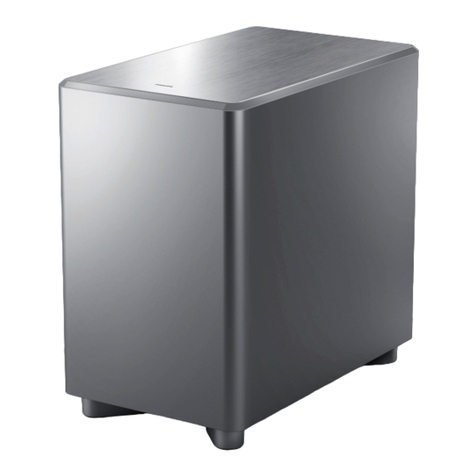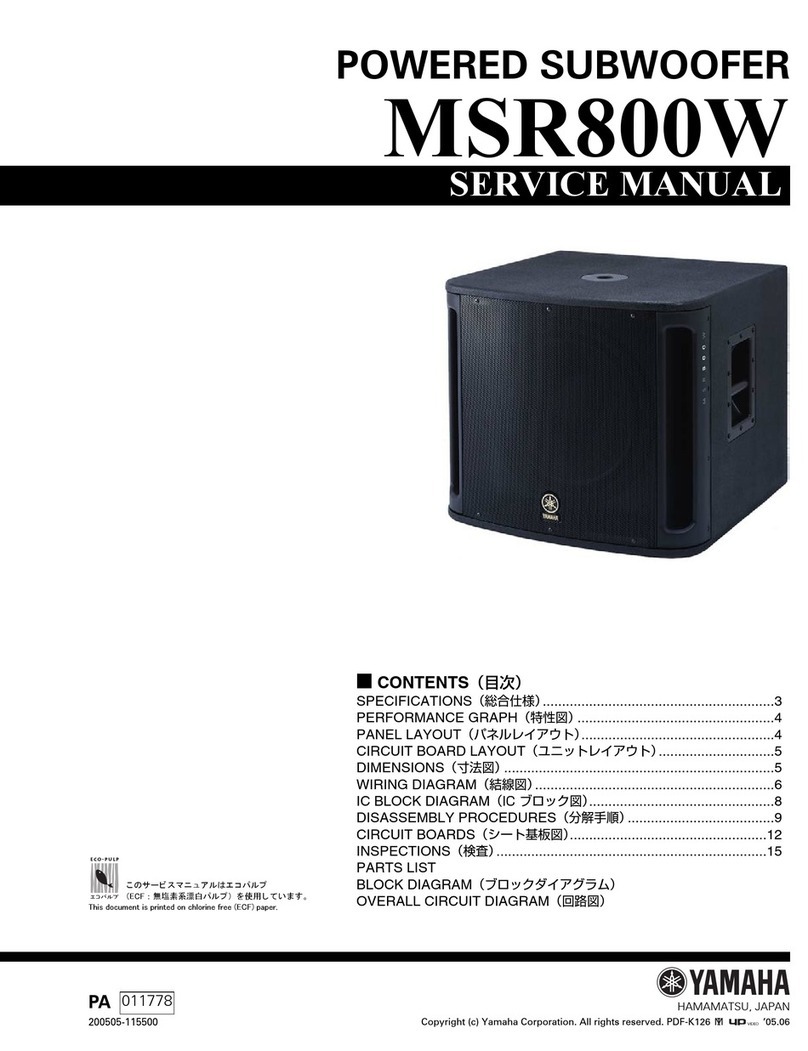K-array KS5 User manual

KS5 Ver. 1.3
KS5
USER GUIDE
English

KS5 Ver. 1.3
2
TABLE OF CONTENTS
SYMBOLS ................................................................................ 3
1. INTRODUCTION ..................................................................... 4
2. KEY FEATURES ...................................................................... 4
3. APPLICATIONS ....................................................................... 4
4. SAFETY INFORMATION ............................................................ 5
5. UNPACKING ......................................................................... 7
6. Ph YSICAL ............................................................................. 8
7. AMPLIFIER ............................................................................ 9
7.1 AC POWER ........................................................................................ 9
7.2 VOLTAGE REQUIREMENT ....................................................................... 9
7.3 CURRENT REQUIREMENT ...................................................................... 9
7.4 PROTECTION CIRCUITRY ......................................................................10
7.5 REAR PANEL ....................................................................................10
7.6 RS485 NETWORK .............................................................................. 12
8. TOUCh SCREEN FUNCTIONS ................................................... 13
9. SERVICE .............................................................................14
10. TEChNICAL SPECIFICATIONS ..................................................15

KS5 Ver. 1.3
3
This symbol alerts the user to the presence of recommendations about
product’s use and maintenance.
This symbol alerts the user to the presence of recommendations about the
product’s use and maintenance.
K-array declares that this device is in compliance with applicable CE
standards and regulations. Before putting the device into operation, please
observe the respective country-specific regulations!
WEEE
Please dispose of this product at the end of its operational lifetime by bringing
it to your local collection point or recycling center for such equipment.
This device complies with Restriction of Hazardous Substances Directive.
SYMBOLS
Warning! Dangerous voltages: RISK of electric shock.
Terminals marked with this symbol are HAZARDOUS LIVE and the external
wiring connected to these terminals requires installation by a qualified
professional or the use of ready-made leads or cords.

KS5 Ver. 1.3
4
1. INTRODUCTION
2. KEY FEATURES
3. APPLICATIONS
The K-array KS5 is a self-powered subwoofer system. It is best suited for high-power extended bass
response applications in arenas, theatres, stadiums, concert halls, houses of worship and outdoor
events. The 21” loudspeakers feature neodymium magnets with 6” voice coils driven by powerful D-class
amplifiers. The large ports are designed to be fully symmetrical to the speakers, which means the back
loading on the drivers is consistent and even with no port air turbulence. The triangle port construction
also provides excellent structural integrity and strength, effectively eliminating any box resonance.
The rear panel provides inputs for both balanced line signals and digital signals in AES/EBU protocol,
also on an XLR for ease of cabling. An integrated touch screen provides intuitive managing and editing
of powerful DSP controlling.
All DSP functions, including EQ can be controlled with remote managing software via USB or RS485,
again conveniently on a standard XLR. There are different DSP presets, specifically made by K-array to
optimize the system performance of the variety of device configuration available. In addition the user
can also create, save, and store his/her own personal presets on the KS5 module.
All KS5 components are designed by the K-array R&D department and custom-made under the K-array
quality control system.
•Self powered
•Integrated DSP with multiple analog and
digital inputs
•Onboard touch screen with matrix control
•RS485 and USB connectivity for remote
control
•Large and medium scale events
•Touring sound reinforcement
•Theatres, Stadiums, Concert halls, Arenas
•Houses of worship

KS5 Ver. 1.3
5
This symbol alerts the user to the presence of
recommendations about the product’s use and
maintenance.
The lighting flash with arrowhead symbol within
an equilateral triangle is intended to alert the
user to the presence of not isolated, dangerous
voltage within the product enclosure that may
be of magnitude to constitute a risk of electrical
shock.
Read these instructions - Keep these instructions - Heed all warnings
4. SAFETY INFORMATION
Warning. Failure to follow these safety instructions could result in fire,
shock or other injury or damage to the device or other property.
IMPORTANT SAFETY INSTRUCTIONS
•Read these instructions.
•Keep this instructions.
•Heed all warnings.
•Follow all instructions.
•Do not use this apparatus near water.
•Clean only with dry cloth.
•Do not block any ventilation openings. Install in accordance with the manufacturer’s instructions.
•Do not install near any heat sources such as radiators, heat registers, stoves, or other apparatus
(including amplifiers) that produce heat.
•Do not defeat the safety purpose of the polarized or grounding-type plug. A polarized plug has two
blades with one wider than the other. A grounding type plug has two blades and a third grounding
prong. The wide blade or the third prong are provided for your safety. If the provided plug does not
fit into your outlet, consult an electrician for replacement of the obsolete outlet.
•Protect the power cord from being walked on or pinched particularly at plugs, convenience receptacles,
and the point where they exit from the apparatus.
•Only use attachments/accessories specified by the manufacturer.
•Use only with the cart, stand, tripod, bracket, or table specified by the manufacturer, or sold with
the apparatus.
•When a cart is used, use caution when moving the cart/apparatus combination to avoid
injury from tip-over.
•Unplug this apparatus during lightning storms or when unused for long periods of time.
•Refer all servicing to qualified service personnel. Servicing is required when the apparatus has been
damaged in any way, such as power-supply cord or plug is damaged, liquid has been spilled or objects
have fallen into the apparatus, the apparatus has been exposed to rain or moisture, does not operate
normally, or has been dropped.

KS5 Ver. 1.3
6
WARNING
•Since the device is a CLASS I apparatus, it must be only connected to an AC three-wire grounding outlet.
If your outlet isn’t grounded, contact a licensed electrician to replace it with a property grounded
outlet.
•To reduce the risk of electric shock, unplug the AC mains connector before installing audio cable.
Reconnect the power cord only after making all signal connections. Do not use the product if the
power cord is broken or frayed. Protect the power cord from being walked upon or pinched.
•To completely disconnect this apparatus from the AC mains, disconnect the power supply cord plug
from the AC receptacle.
•Avoiding hearing damage. Professional loudspeakers are capable of producing extremely high sound
levels and should be used carefully. Never stand close to loudspeakers driven at high volume. Set
the volume to a safe level. You can adapt over time to a higher volume of sound that may sound
normal but can be damaging to your hearing. Hearing loss get worse every time you’re exposed to a
sound level of 90 dB or over for an extended period of time. If you experience ringing in your ears
or muffled speech, stop listening and have your hearing checked. The louder the volume, the less
time is required before your hearing could be affected.
•Voltage requirement. Make sure that the supplied voltage stays within the specified range. Verify that
your mains connection satisfies the power ratings of the device.
•Only connect the power supply to an appropriate power outlet
•Do not install the amplifier in wet or humid locations without using weather protection.
•TO REDUCE THE RISK OF FIRE OR ELECTRIC SHOCK, do not expose this apparatus to rain or moisture
and objects filled with liquids, such as vases, should not be placed on this apparatus.
•The main plug of the power supply cord shall remain readily accessible.
CAUTION
•Choking Hazards. This device contains small parts, which may present a choking hazard to small
children. Keep the device and its accessories away from small children.
•It is important that loudspeaker systems are used in a safe manner.
•Do not make repairs yourself. Caution, risk of electric shock. Do not open the device, it contains
potentially hazardous voltage. Never attempt to disassemble, repair or modify the system yourself.
Disassembling the unit may cause damage that is not covered under the warranty. The device
contains no user-serviceable parts. Repairs should only be performed by factory trained service
personnel. Do not plug the power cord in if you suspect that your device needs service or repair.
•Sound distortion. Do not operate speakers for an extended period of time with sound distortion. This
is an indication of malfunction, which in turn can generate heat and result in a fire.
•Cooling. During the use, it is normal for the device to get warm. The exterior of the device functions
as a cooling surface that transfers heat from inside the unit to the cooler air outside. The device
should be placed so that its location does not interfere with its proper cooling. For example, the
device shouldn’t be placed next to surfaces that can interfere with the properly cooling of the rear
panel’s radiators. When operating, the device should not be cover with additional protections.

KS5 Ver. 1.3
7
•Temperature. Operate the device in a place where the temperature is between -20°C and 35°C (-4°F
to 95° F). Avoid dramatic changes in temperature or humidity when using it, as condensation may
form on or within the device.
•Take care not to spill any food or liquid through the device’s grill. Do not attempt to dry the device
with an external heat source, such as a hair dryer.
•Carrying, handling and installing the device. The device contains sensitive components. Do not drop,
disassemble, open, crush, bend, deform, puncture, shred, incinerate, paint, or insert foreign objects
into it. If your device has been dropped or damaged unplug the power cable immediately.
•Set up. Set up your device on a stable retaining horizontal surface. If combined or mechanically
connected with other products, always verify the stability of the resulted system. Install the unit
only in a location that can structurally support the weight of the unit, far away from people who
can interfere with the stability of the system. In case of outdoor installation, protect the device from
rain and moisture. Assure that the wind does not interfere with the system’s stability, taking extra
securities like chains, weights, ropes or any other certified anchoring systems. Doing otherwise may
result in the unit falling down, causing personal injury or property damage or even death. The system
should only be suspended by qualified personnel following safe rigging practices. Secure fixings
to the building structure are vital. To clarify any doubt you may have, seek help from architects,
structural engineers or other specialists.
•This audio system is not intended for use in the operation of nuclear facilities, aircraft navigation
or communication systems, air traffic control systems,or for any other uses where the failure of the
audio system could lead to death, personal injury, or sever environmental damage.
5. UNPACKING
Each K-array speaker is built to the highest standard and thoroughly inspected before leaving the
factory. Upon arrival, carefully inspect the shipping carton, then examine and test your new amplifier.
If you find any damage, immediately notify the shipping company. Only the consignee may institute a
claim procedure regarding the system’s electronic equipment.

45,7 in
1162 mm
23,2 in
590 mm
1,5 in
39 mm
33,5 in
850 mm
4,8 in
122,5 mm
KS5 Ver. 1.3
8
6. Ph YSICAL
Weight
104.4 kg (230.2 lb)

KS5 Ver. 1.3
9
7.1 AC POWER
The amplifier module and any audio equipment connected to it (mixing consoles, processors, etc.) must
be properly connected to the AC power distribution, preserving AC line polarity. Every grounding point
must be connected to a single node or common point using the same cable gauge as the neutral and
line cable. Bad grounding connections between speakers and the rest of the equipment may produce
noise, hum or serious damage to the input/output stages in the system’s electronic equipment.
Before applying AC to any K-array self-powered speaker, be sure
that the voltage potential difference between neutral and earth
ground is less than 5 VAC.
7. AMPLIFIER
7.2 VOLTAGE REQUIREMENT
The auto-range power supply feature allows the amp unit to operate safely and with no audio discontinuity
when the AC voltage stays within a nominal range of 100 - 240 V (operating range 85 - 265 V) at 50
to 60 Hz. Please verify that your AC main connections are capable of satisfying the power rating for the
device.
CAUTION. Do not connect the system to AC power mains
exceeding 265 V. Doing so will cause significant damage to the
device and create serious risk for users!
7.3 CURRENT REQUIREMENT
The amplifier presents a dynamic load to the AC mains, drawing additional current as operating levels
increase. Different cables and circuit breakers heat up at varying rates, so it is essential to understand
current ratings and how they correspond to circuit breaker and cable specifications. Maximum continuous
RMS current - measured over a period of at least ten seconds - is used to calculate the temperature
increase in cables, which drives the proper size and gauge cable and rating for slow-reacting thermal
breakers. Maximum burst RMS current - measured over a period of approximately one second - is used
to select the rating for fast reacting magnetic breakers.
For best performance, voltage drops should not exceed 10% at 100 V or 10% at 230 V. The minimum
electrical service amperage required by a K-array loudspeakers system is the sum of their maximum
continuous RMS current. K-array recommends allowing an additional 30% above the minimum amperage
to prevent peak voltage drops at the service entry.

KS5 Ver. 1.3
10
1
2
4
6
3
5
910
7
8
11 12
13
14
15
16
17
18
19
7.4 PROTECTION CIRCUITRY
Both the Power supply and the amplifier sections are equipped with several protection circuits.
Power supply protections aim to isolate a faulty section in electrical power system from the rest of
the device in order to prevent the propagation of the fault and limit device damages. They comprise
overcurrent, overvoltage and thermal protections.
Amplifier protections are triggered by audio signal current and voltage – by comparing input and output –
and NTC (Negative Temperature Coefficient) thermistors. A Peak Current Shut Down and a Temperature
Protection Limiter protect the output stage.
High frequency stationary signals, like steady sinusoidal signals – improperly referred as continuous or
permanent signals – with high amplitude tend to stress the amplifier section of the modules as well as
the loudspeakers voice coils. When a high frequency stationary loud signal is feed into the amplifier a
dedicated Limiter limits its mean current depending on its level and frequency.
7.5 REAR PANEL

KS5 Ver. 1.3
11
1) CH1 Line Input. XLR line level input with +4 dBu sensitivity.
2) CH2 Mic/Line Input. XLR input with selectable sensitivity for Mic (-30 dBu) or Line (+4 dBu).
3) Mic/Line Switch. Selects CH2 input sensitivity for Mic ( -30 dBu) or Line ( +4 dBu) level.
4) Phantom Power Switch. Turns phantom power (48V) on/off on CH2 input.
5) Limiting LEDs. Independent LEDs for the CH1 and CH2 inputs, which blink when the optical limiter
engages to protect the corresponding pre-amp circuit. Limiter threshold is +5 dBu.
6) CH1 Parallel Line Out. XLR parallel output providing a direct signal from the CH1 Line Input. This
output cannot be processed or controlled via the K-Framework software.
7) DSP Out. When the DSP Out switch is not pressed (off), this connector provides a direct signal
from the CH2 input. At the moment this connector doesn’t output any signal if the DSP Out switch
is pressed (on). This function will be useful for future applications.
8) DSP Out Switch. See point 7.
9) AES/EBU Digital Input. XLR input connector for two-channel AES/EBU digital audio, accepting
sample rates up to 96 kHz.
10) AES/EBU Digital Output. XLR output, providing two-channel digital audio from AES/EBU Digital
input with no latency.
11) REMOTE RS485 Link Input. XLR input for connecting the KMT from another RS485 device in a
K-Framework network. RS485 Link Input can also be used to connect a computer running the
K-Framework software (requires K-USB USB-to-RS485 adapter).
12) REMOTE RS485 Link Output. XLR output for connecting additional RS485 devices in a K-Framework
network.
13) REMOTE USB Input. Connects a computer running the K-Framework software for remote control
of the device. Users can manage an entire network of RS485 devices with one PC connected via
USB.
14) Power switch. Turns the device on and off.
15) AC Input. PowerCon input for AC power. See p. 11 for voltage and power requirements.
16) AC Link. PowerCon output for feeding AC mains power to additional K-array components with a
PowerCon AC input socket.
17) Power On LED. Indicates the system is ON.
18) TOUCH SCREEN Control panel. Provides access to the main functions of the DSP on board (see
Section 8.)
19) 5 Volt Power Connector. Provides 5VDC/500mA to power accessories.

XLR cable XLR cable
USB cable
PC connected via USB cable
XLR cable XLR cable
XLR cable
K-USB
PC connected via XLR cable + K-USB accessory
KS5 Ver. 1.3
12
7.6 RS485 NETWORK
The RS485 Link Input and RS485 Link Output on the rear panel allow users to create a network of
K-array devices which are manageable through the K-Framework software on a PC (see K-Framework
User Guide
downloadable from the K-array web site). All devices can be linked with standard XLR cables.
The PC can be connected to the network either with USB cable or XLR cable (requires K-USB USB-to-
RS485 adapter accessory) as shown in the diagrams below.

KS5 Ver. 1.3
13
8. TOUCh SCREEN FUNCTIONS
The main functions of the onboard DSP can be managed with the integrated touch screen. Functions
are grouped into six pages, shown as icons on the Home page.
To reach the Home page from any of the pages,
touch the
Home
button.
h OME PAGE
LEVELS
The Levels page allows users to manage the amplitude of
the input signal (whether analog or digital).
If you have a cluster composed of more then one unit, we
recommend setting the same input levels on all units.
MATRIX
The Matrix page allows users to switch on/off the four
inputs channels independently.
IN1
and
IN2
are the two
analog inputs,
AES1
and
AES2
are the two channels of the
AES/EBU digital input.
DEL AY
The Delay page allows users to delay the audio signal sent
to the unit. Users can set the delay in milliseconds (ms) or
meters (mt).

KS5 Ver. 1.3
14
LED
On the Home page click on
LED
to switch on/off the LED
situated at the front of the unit.
PRESET
The Preset page allows users to load presets stored on-
board.
INFO
The Info page contains information about the current
software and firmware, the current preset loaded and the
Board ID
of the device.
The
Board ID
is a number which identifies the device when
it is connected in a K-framework network (see Paragraph
7.6). Make sure that each device in the network has a
different ID number.
9. REMOTE CONTROL - K-FRAMEWORK
All DSP functions, including system EQ and delay, can be controlled using the K-framework software.
The K-framework software and its user guide can be downloaded from our website at http://www.k-
array.com/software_download

KS5 Ver. 1.2
15
10. SERVICE
To obtain service:
1) Contact the official K-array distributor in your country. Your local distributor will direct you to the
appropriate service center.
2) If you are calling for service, please have the serial number(s) of the unit(s) available for reference.
Ask for Customer Service, and be prepared to describe the problem clearly and completely.
3) If the problem cannot be resolved over the phone, you may be required to send the unit in for
service. In this instance, you will be provided with an RA (Return Authorization) number which
should be included on all shipping documents and correspondence regarding the repair. Shipping
charges are the responsibility of the purchaser.
Any attempt to modify or replace components of the device will invalidate your warranty. Service must
be performed by an authorized K-array service center.
Cleaning:
Use only a soft, dry cloth to clean the housing. Do not use any solvents, chemicals, or cleaning
solutions containing alcohol, ammonia, or abrasives. Do not use any sprays near the product or
allow liquids to spill into any openings.
Ver. 1.3

KS5 Ver. 1.3
16
10. TEChNICAL SPECIFICATIONS
The contents of this manual are furnished for informational purposes only. K-array s.u.r.l. assumes no responsibility for any errors or inaccuracies that may
appear in this manual. K-array s.u.r.l. reserves the right to make modifications without prior notice.
Transducers
Frequency range 1
Maximum SPL 2
Coverage
Notes for data
1. With dedicated presets.
2. Maximum SPL is calculated using a signal with crest factor 4 (12dB) measured at 1 m.
3. EIAJ sine wave 8/32 burst
New materials and design are introduced into existing products without previous notice. Present systems may differ in some respects from those presented in this catalogue.
Input Sample Rate and
ResolutionFrequency
Built-in DSP
Controls
Connectivity
GENERAL
2x 21” neodymium magnet woofer with
5.31” voice coil
25 Hz – 120 kHz (-6 dB)
141 dB (peak)
Omni
INTERNAL PROCESSING
Up to 96 kHz @ 24 bit with internal SRC
and jitter correction
Input gain, delay up to 330 ms,
8 full parametric IIR filters (Peaking,
Shelving, Hi/Lo pass, Hi/Lo Butterworth),
FIR filter for electronic beam steering
Onboard preset,
Level and temperature remote
monitoring
CONTROLS AND CONNECTIVITY
Remote control with dedicated PC
software via USB or RS485.
Onboard touch screen display.
Analog:
2x XLR (bal) input signal
2x XLR (bal) parallel output
Digital:
1x XLR AES3 input
1x XLR AES3 output
Remote connectivity:
1x XLR RS485 serial input
1x XLR RS485 serial output
1x USB-B inlet
MAINS:
1x powerCON
1x powerCON link
Type
Peak Output Power
Operating Range
Power Consumption
Protections
Dimensions (WxHxD)
Weight
IP rating
AMPLIFIER MODULE
2-ch., switch mode, class D
2x 3500 W @ 2 Ω 1% THD+N 3
100-240V AC, 50-60 Hz with PFC
600 W @ 4 Ω load, Pink noise 1/8 rated power
Over Temp. (Power Limiting – Thermal
Shutdown), Short Circuit/Overload Output
Protection, Power Limiting, Clip Limiter/
Permanent Signal Limiter, High Frequency
Protection
HANDLING
1162 x 590 x 851 mm (45.7 x 23.2 x 33.5 in)
net dimensions
104.4 kg (230.16 lb)
20 (53 with K-AMPCOVER accessory)
Table of contents
Other K-array Subwoofer manuals
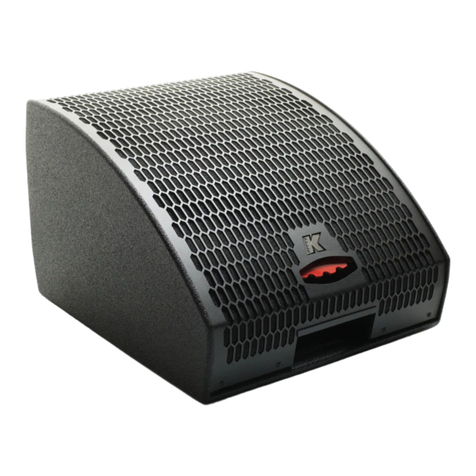
K-array
K-array KM112 User manual
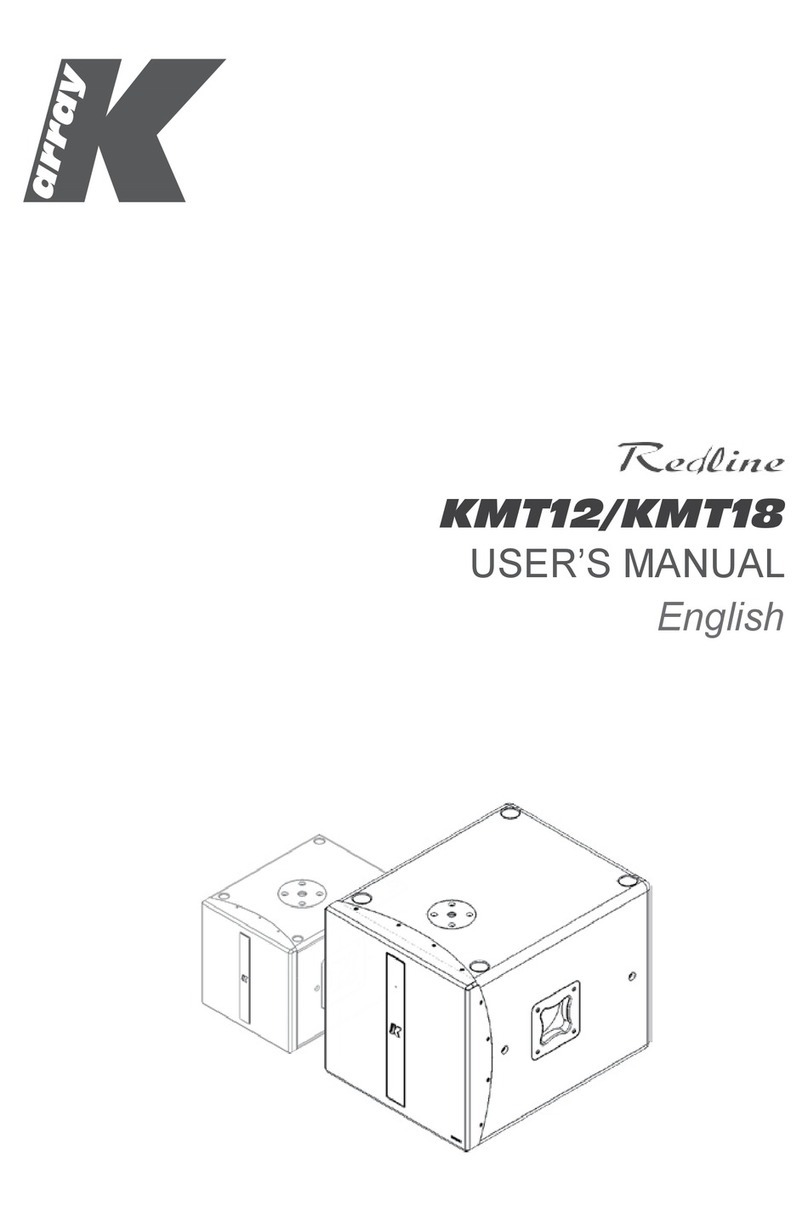
K-array
K-array Redline KMT12 User manual
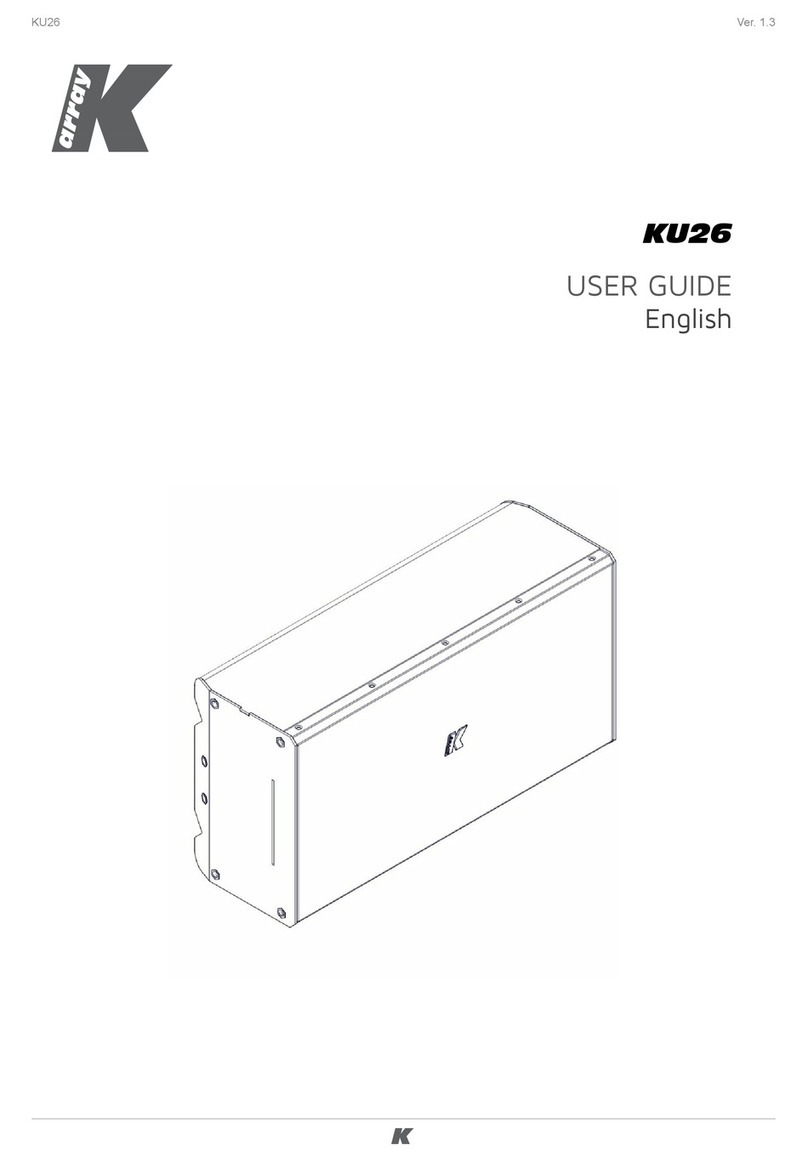
K-array
K-array KU26 User manual
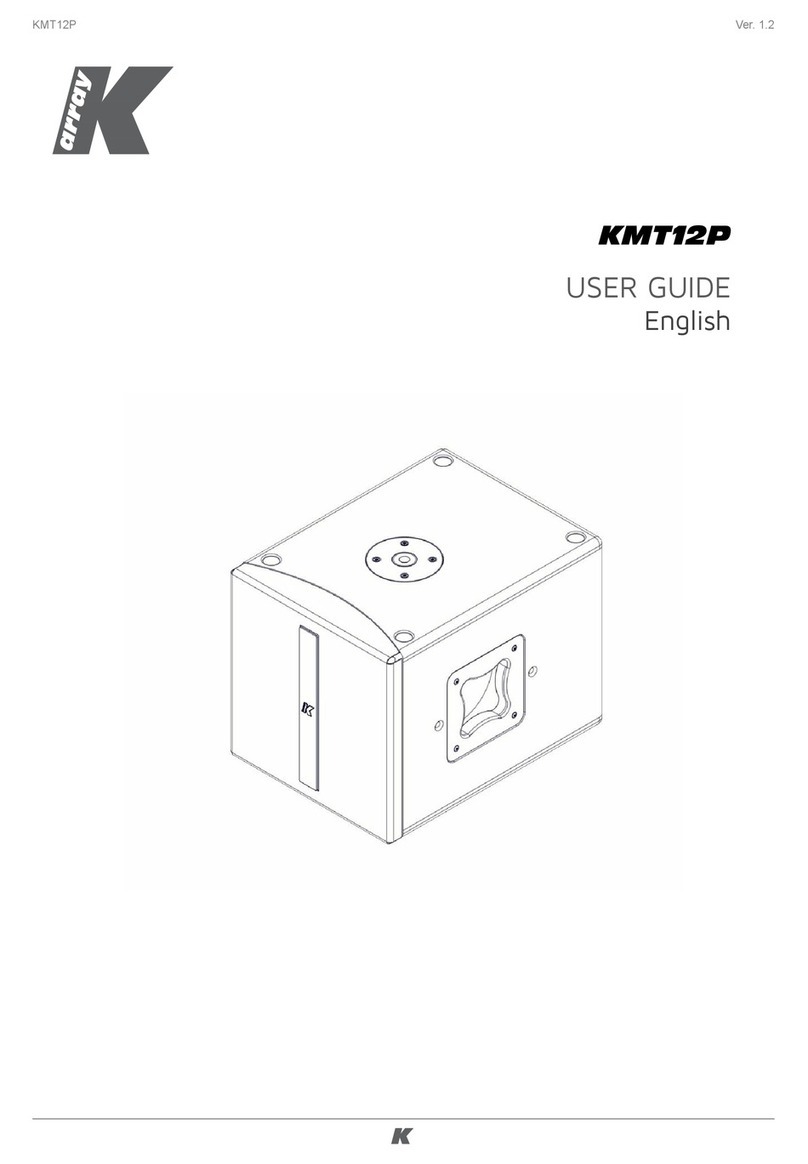
K-array
K-array KMT12P User manual
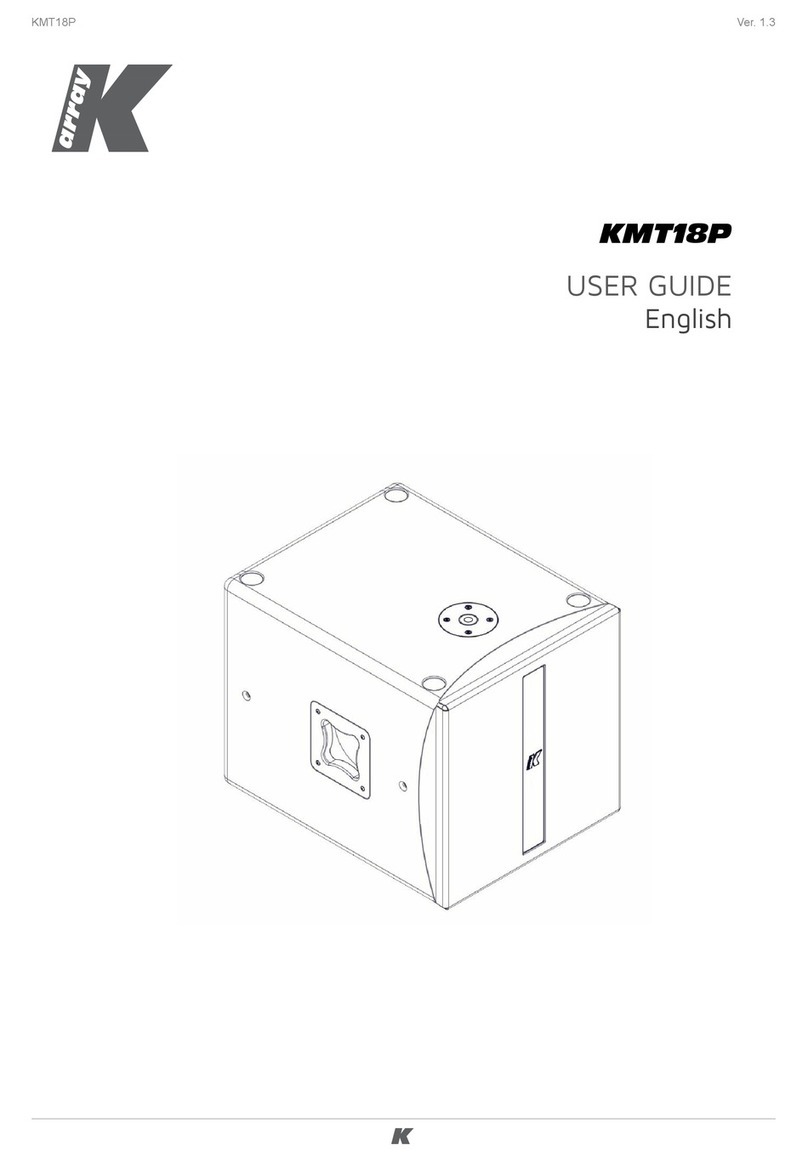
K-array
K-array Thunder-KMT18P User manual
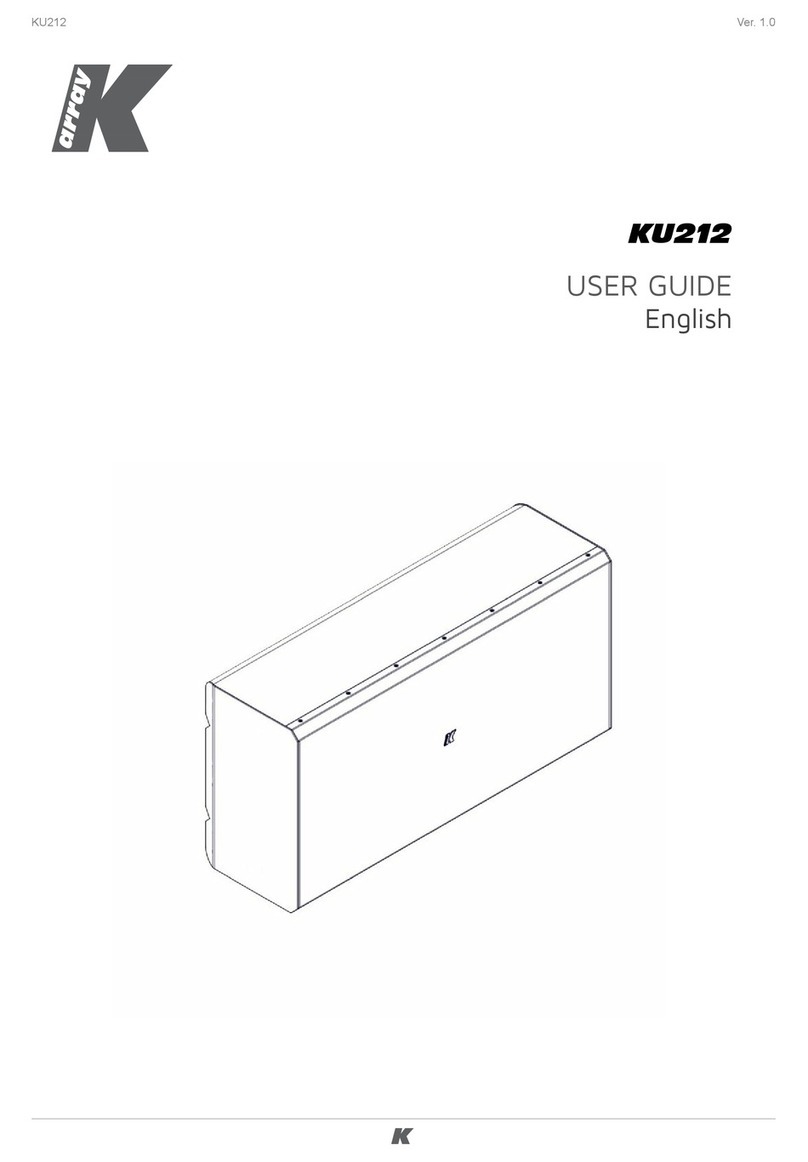
K-array
K-array Rumble-KU212 User manual
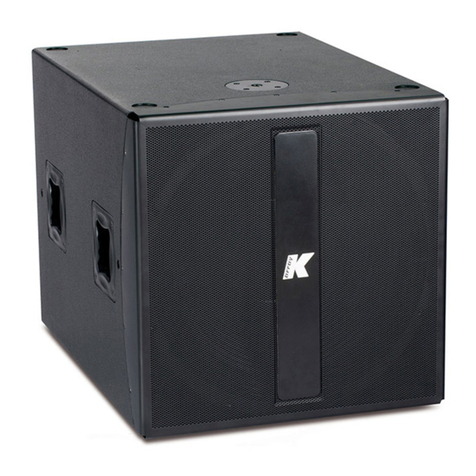
K-array
K-array Redline KMT21 User manual
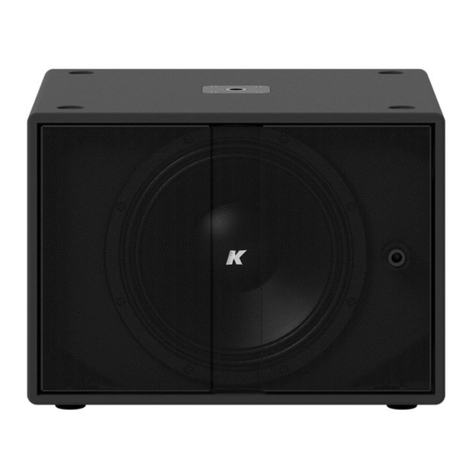
K-array
K-array Thunder-KS User manual
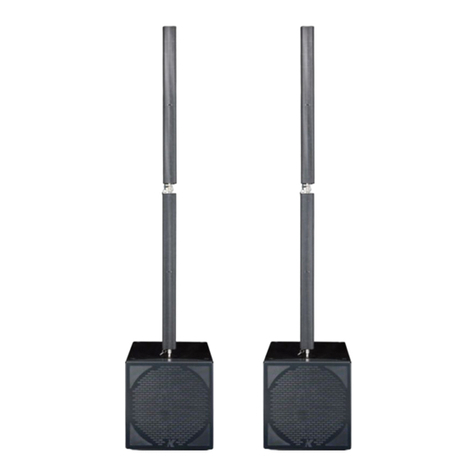
K-array
K-array KR400S User manual

K-array
K-array KU44 User manual
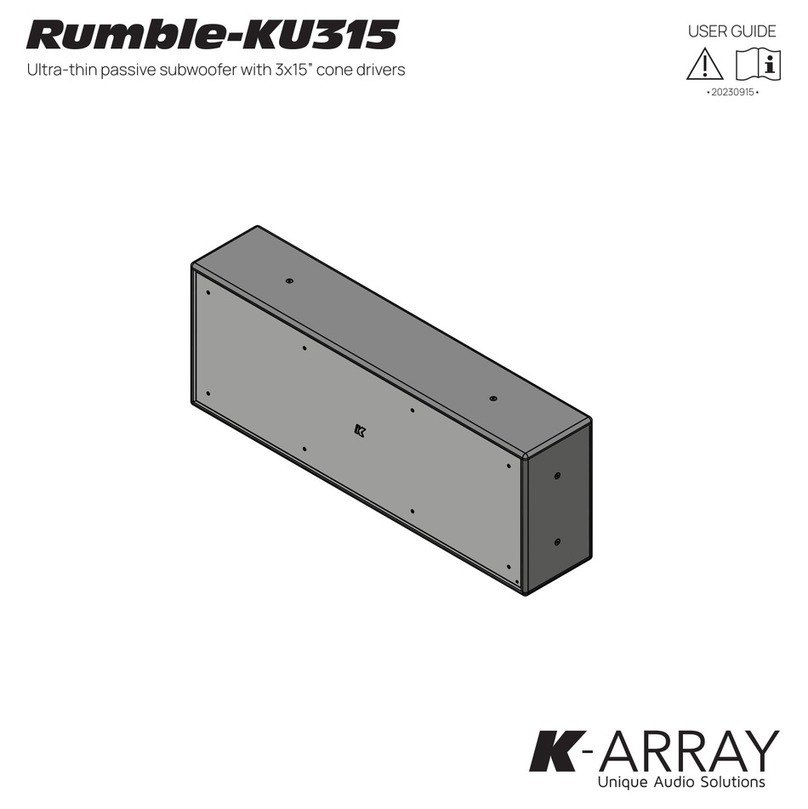
K-array
K-array Rumble-KU315 User manual
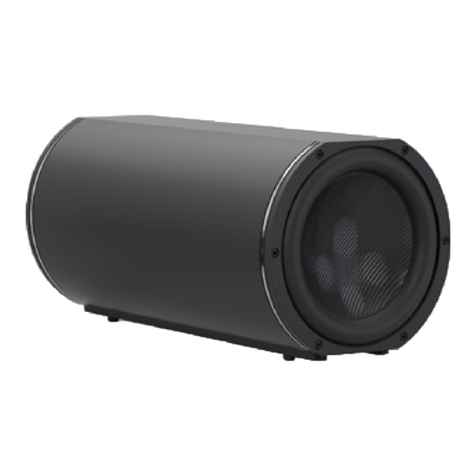
K-array
K-array Truffle Series User manual

K-array
K-array Redline KMT12 User manual

K-array
K-array Ko70 User manual
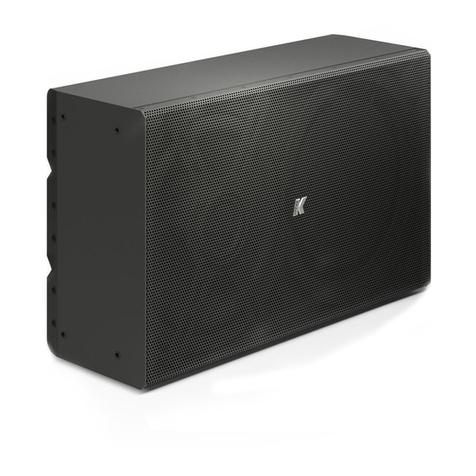
K-array
K-array KU210 User manual
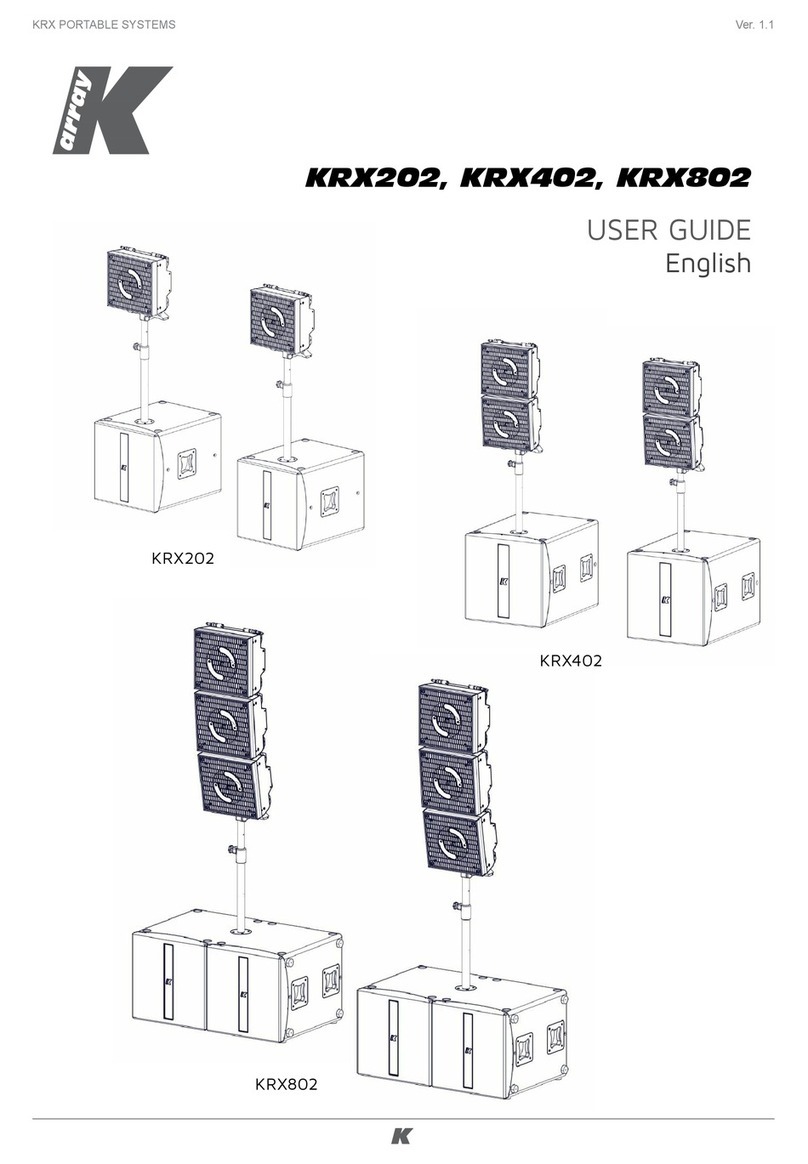
K-array
K-array KRX202, KRX402, KRX802 User manual
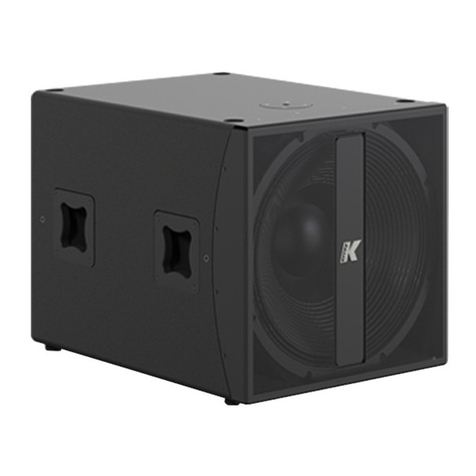
K-array
K-array KMT21P User manual
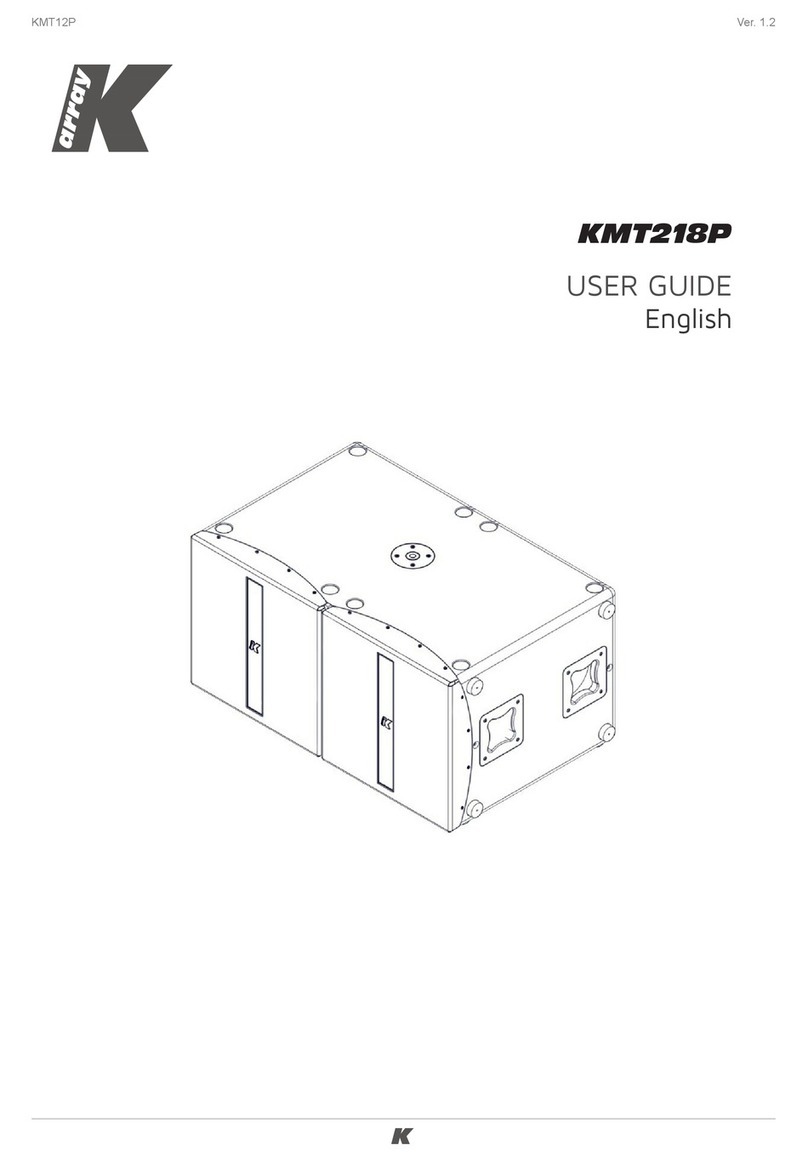
K-array
K-array Thunder-KMT218P User manual
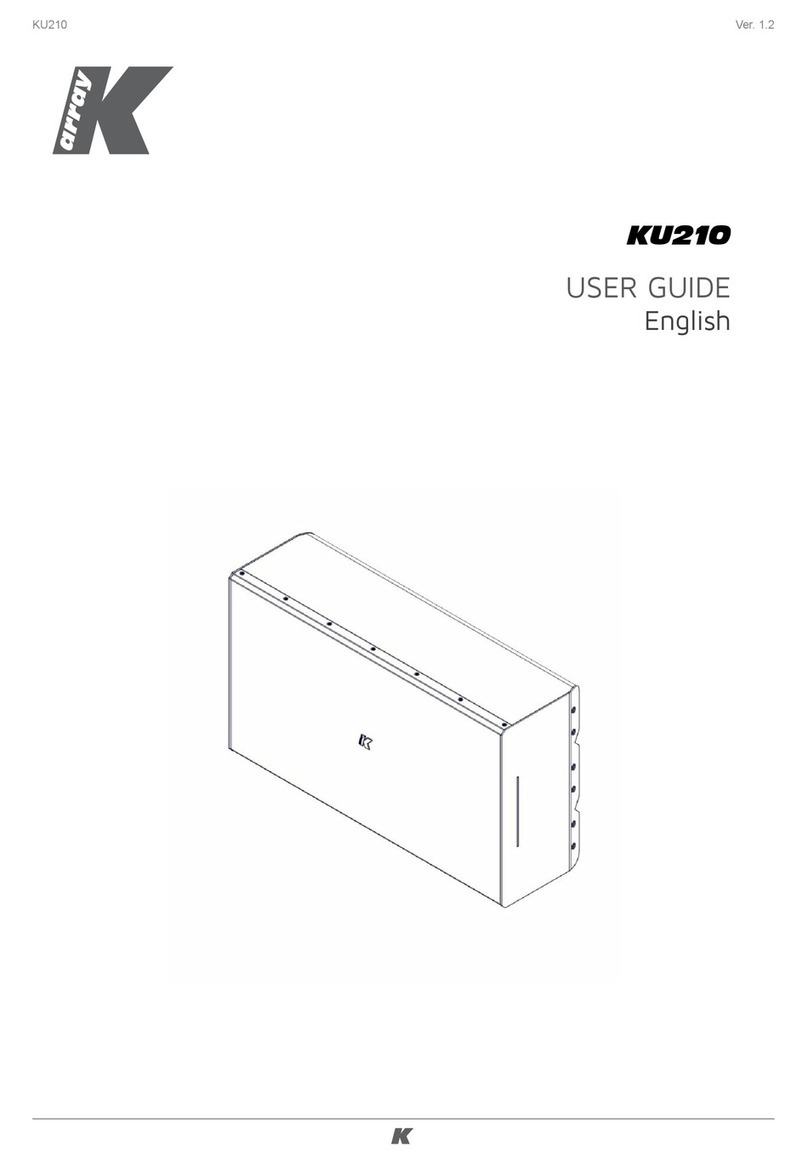
K-array
K-array KU210 User manual
